The Story of Our "Huevos Rancheros" (with periodic updates)
By the Lady of McCamley: mother of 3 homeschooled, now grown kids, (proud grandma), wife to a chicken enabling husband, former Guide Dog Puppy raiser -- 7 projects -- and former 4-H leader and helper (speech, sewing crafts, Vet science, dogs), food lady to one adoring Sheltie (now deceased..RIP little friend), now food lady to a goofy but sweet Rat Terrier (who will chase rats for me!). Humble and grateful servant to 1 cat, overseer of 15+ chickens (that's the number I'm willing to admit to...I average 18 to 20-ish). High school competitive debate coach, and a private after-school ESL tutor who LOVES to use chickens for our nature and science studies (especially brooding hens)!
The saga of our first try, March to December 2010: Nugget (Buff Orpington), Teriayki (Brown Leghorn), Lucy and Ethel (RIR's)
I don't remember whose idea it was first to have chickens in our Northwest, semi-suburban, backyard, but the idea grew until it reached fruition in the purchase of 4 chicks in March 2010. My daughter became a vet tech (all the Vet Science 4H units, and the instigator behind those family guide dog puppy raising projects), and wanted to go into farming (she married an organic farmer). I grew up with horses and cattle in a rural ranching area, and my Grandmother had had a chicken farm (which I loved to visit), so we two were quick to jump on board. My techie husband and son, and liberal arts daughter allowed themselves to be pulled along for the journey....and fun. After much thought about where to put a henhouse and coop, and differing ideas, my husband and I realized we were "discussing" the whole matter as we stared absently at the kids old play structure left vacant and abandoned. We both lept at the idea at the same time. Why not there! So there it became, and the old slide platform and swing structure turned into the coop and hen house.


Disaster Strikes
Unfortunately, in the late fall, our normally wet but moderate Northwest climate took a turn for sub-freezing temperatures. So during a particularly harsh cold snap, we put in a small flood lamp for heat which the chickens must have knocked down from its fixture. It started the fire that burned down the whole hen house during the night.

Amazingly nothing but the henhouse itself caught on fire even with the wood fence, trees, and woodpiles (ours and our neighbors) so close by (thank you to the Great Northwet for that). No one, including the neighbors, noticed anything amiss during the night. God's protection was surely over us. The morning greeted us with nothing but ash on the ground in the place of the hen house. The poor birds had no chance for escape, so we lost the whole of our first flock. (EEks, and they had just started laying "real good!")
The morning greeted us with nothing but ash on the ground in the place of the hen house. The poor birds had no chance for escape, so we lost the whole of our first flock. (EEks, and they had just started laying "real good!")
We begin again, February to June 2011
Greatly disappointed from the failure of our first attempt, but also greatly relieved that no family life or other property had been damaged, we armed ourselves with determination, some hard-earned knowledge from the "school of hard knocks," a Wilco gift-card from one good friend, and a small cast-off pre-fab hen house from another good friend, to begin again in the Spring of 2011. The new hen house, constructed from the pre-fab (as the middle story/roof), was expanded with new base and extended feed bin and egg boxes:



Spring 2012
2 Black SL's (Huevos and Foo Young); 4 Gold Sex Links (Muna, Chalah, Eggroll and Frittata) :-D

February 2013
This year we got our new chicks the "natural way."
Last spring we purchased a Silkie hen at the Canby Chicken Swap. She was a known broody and foster mother. She wanted to brood in November, but I let her sit through without using her so I could know what her behavior was like and at the time had no confidence in winter brooding, having never used a broody. Next, we waited for her to go into a good brood for spring, which occurred late January (her timing not ours). A good friend's daughter had a flock with a rooster, so I rushed out and got some fertile eggs from her. Waiting until night, I swapped out the 2 banty eggs our Silkie was trying to hatch and replaced them with the 5 fertile eggs. She settled in with a glare at me and went into a serious brood.
Candling showed that only 3 would be viable, which indeed hatched on February 8.
Wanting more than 3 chicks, I purchased two, 2 day Wyandotte chicks from a local feed store. Research had told me to wait until night to put them in with the hen to reduce the likelihood she would reject them. However, both died within the next 2 days even though the hen was taking good care of them. After talking with the feed store, we figured out it simply had been too much stress change for the chicks...too many changes in too short a time from hatching to travel from farm to feed store to travel to my home, to being kept in a warm box until night, then trying to adjust to a hen. The feed store willingly replaced the chicks and recommended taking them immediately to the hen.
I did, and the little brood of 5 are happy and healthy with momma hen, who is teaching them how to scratch, how to find food, and keeps them nice and warm in her feathers.
This has been a GREAT project with my hens

At 2 weeks of age. 3 hatchlings and 1 foster chick (silver died due to wandering off into cold).
UPDATE: Unfortunately I could not keep those first fosters alive...they all succumbed to the elements after about 2 weeks of age, and I gave up trying with that hatch. The broody hatched chicks were thriving even in the winter cold, and grew into lovely hens that laid at 14 to 16 weeks of age.
....you can see the rebuilt coop on the right...the second coop on the left (which failed miserably as a brooding coop as the silly broodies wouldn't use it). I keep these as my main coops...each can hold about 8 to 10 for roosting...they free range during the day.The Coops Proper

UPDATE 2015
A lot of brooding has taken place since that first brood in February 2013. My faithful Oma-San (black Silkie) brooded every 3 to 4 months, and I took advantage of that as much as I could. I also used any "volunteer" that would come my way.
It soon became apparent that brooding in the main coop was not going to work well...too many eggs getting stomped on, too many wrong eggs ending up under the broody. Sooo, we built a second coop for the expanding flock...hoping that would be the brooding area. It was still connected to the main coop with run, so it would be ideal? Right? Unfortunately we obviously had forgotten to tell our broody hens as they continued to clog up the main coop. A new plan was needed.
We like to re-use and recycle, so we turned a couple of large, wooden packing crates (the kind companies use to store their product exhibits in) into a rabbit hutch type brooding hutch with its own connected run. This has worked like a charm. I can easily brood 2 hens at a time, (3 in a pinch) and have had as many as 8 to 10 chicks (could do probably 12). The enclosed netted run acts as a grow out pen, and keeps our littlest flock members from becoming hawk dinner as the Cooper's Hawks love to fly by and check out the chicken nuggets. It also allows the main flock to come by and see the new members which eases with flock integration.
Here's photos of my third coop...the designated broody hutch and run:


 the completed run re-purposes a car tarp frame
the completed run re-purposes a car tarp frame
And some of my projects over the last few years:


 Buckeyes
Buckeyes



 Rhodebars
Rhodebars


 Black Copper Marans
Black Copper Marans
Grab bag of eggs that yielded a good broody (seasonal) and a Welsummer (nice dark eggs) and several game mixes







 Fostered feed store EE's
Fostered feed store EE's
Sadly this winter 2014, I lost my most beloved and faithful broody hen, Oma-San, to one such hawk...I had her free ranging in the yard with the main flock to finish integrating them as her "babies," along with other "babies" the LF hen had long since left on their own but Oma-San was determined should still have a careful motherly eye, were getting too big to be confined in the grow out pen. Of course a hawk picked off the smallest and most valuable member of my flock!
Broken hearted, I began a new search for another seasoned broody by posting an ad on a local Chicken Swap. A kind hearted Silkie owner saw my ad and felt I would be the perfect home for her first Silkie, and beloved broody, who was 4 1/2 years old and being dropped from her breeding program. She gave me what I have dubbed the "Queen Mum." I also had been looking at Cochin bantams as a good brooding possibility, but could only find young pullets. I had arranged to purchase only 1 pullet, after checking with the Silkie breeder that the Queen Mum would be good with Cochin bantams...she would...she had co-brooded with one before. Funny thing happened on the way to the farms...it turned out the Silkie breeder and the bantam Cochin breeder knew each other, and they together determined that the Queen Mum really needed TWO hand maids to wait on her and keep her warm in her new home...I was notified of this fact...and yes, having no control over chicken math especially when being enabled by other chicken lovers, came home with TWO very pretty 4 month old bantam Cochin pullets that were from a very, very broody Buff momma and a very pretty Mille Fleur dad.
My new broodies...I hope to have many stories and pics of their successes shortly...



The Queen Mum (silkie) and her 2 hand maids Rosie and Mimsy (bantam Cochin)
UPDATE March 2015
The Queen Mum supplied me with a lovely brood this February, and I placed 3 Isbar and 2 Isbar/Maran (Olive Egger) eggs with her. She was dutiful and faithful, but for whatever reason we only had 1 OE egg hatch...none of the others developed chicks (all "quitters"). Not wanting just the 1 chick lonely only, I purchased a couple of California Greys to foster with the OE. My white layer is aging, and I like those white eggs next to the dark Marans and greens in the egg box...it really makes the colors "pop."
The Queen Mum and her first brood for me...1 OE...and the 2 Cal Greys with my OE.


What's Next?
My next projects in waiting are Isbars (since I didn't get any this time), probably some more Olive Eggers, some Cream Crested Legbars, some more Welsummers (lost mine this summer), or more BCM's (breeder has a new line with REALLY dark eggs!), and possibly some Croad Langshans...as well as perfecting fostering with feed store chicks to keep half my flock in those super layers of RSL and BSL.
I am hoping to create a really awesome egg basket filled with dark brown, tans, whites, greens, ice blues, and that elusive purple.
Update December 2016: I now have a sweet, pretty Barnevelder rooster with a brooding harem that includes Cream Legbar, Splash Marans, the OE Isbar/Marans, and now several of his lovely daughters. Results to come
My growing egg basket colors






Greetings from the Lady of McCamley...from my flock to yours
By the Lady of McCamley: mother of 3 homeschooled, now grown kids, (proud grandma), wife to a chicken enabling husband, former Guide Dog Puppy raiser -- 7 projects -- and former 4-H leader and helper (speech, sewing crafts, Vet science, dogs), food lady to one adoring Sheltie (now deceased..RIP little friend), now food lady to a goofy but sweet Rat Terrier (who will chase rats for me!). Humble and grateful servant to 1 cat, overseer of 15+ chickens (that's the number I'm willing to admit to...I average 18 to 20-ish). High school competitive debate coach, and a private after-school ESL tutor who LOVES to use chickens for our nature and science studies (especially brooding hens)!
The saga of our first try, March to December 2010: Nugget (Buff Orpington), Teriayki (Brown Leghorn), Lucy and Ethel (RIR's)
I don't remember whose idea it was first to have chickens in our Northwest, semi-suburban, backyard, but the idea grew until it reached fruition in the purchase of 4 chicks in March 2010. My daughter became a vet tech (all the Vet Science 4H units, and the instigator behind those family guide dog puppy raising projects), and wanted to go into farming (she married an organic farmer). I grew up with horses and cattle in a rural ranching area, and my Grandmother had had a chicken farm (which I loved to visit), so we two were quick to jump on board. My techie husband and son, and liberal arts daughter allowed themselves to be pulled along for the journey....and fun. After much thought about where to put a henhouse and coop, and differing ideas, my husband and I realized we were "discussing" the whole matter as we stared absently at the kids old play structure left vacant and abandoned. We both lept at the idea at the same time. Why not there! So there it became, and the old slide platform and swing structure turned into the coop and hen house.
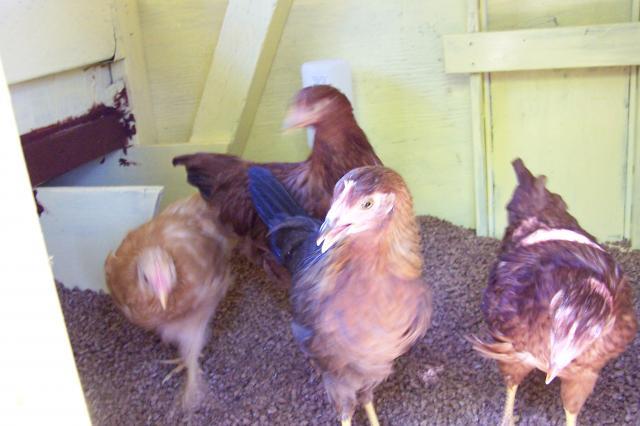
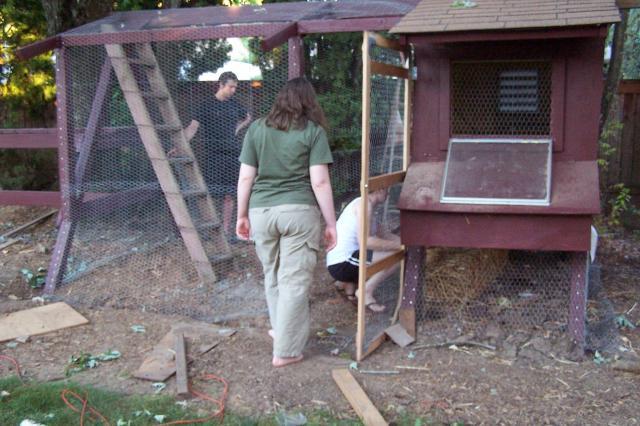
Disaster Strikes
Unfortunately, in the late fall, our normally wet but moderate Northwest climate took a turn for sub-freezing temperatures. So during a particularly harsh cold snap, we put in a small flood lamp for heat which the chickens must have knocked down from its fixture. It started the fire that burned down the whole hen house during the night.
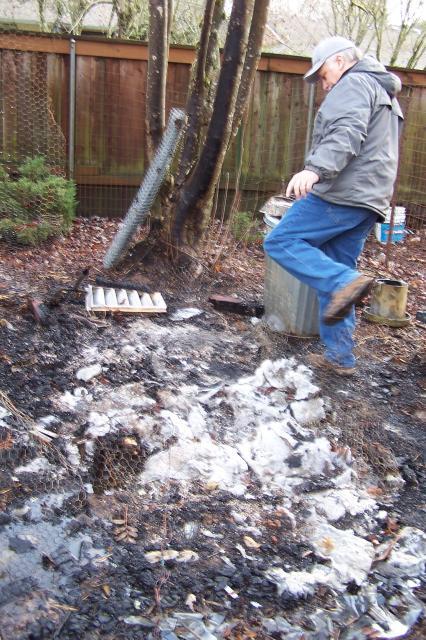
Amazingly nothing but the henhouse itself caught on fire even with the wood fence, trees, and woodpiles (ours and our neighbors) so close by (thank you to the Great Northwet for that). No one, including the neighbors, noticed anything amiss during the night. God's protection was surely over us.
 The morning greeted us with nothing but ash on the ground in the place of the hen house. The poor birds had no chance for escape, so we lost the whole of our first flock. (EEks, and they had just started laying "real good!")
The morning greeted us with nothing but ash on the ground in the place of the hen house. The poor birds had no chance for escape, so we lost the whole of our first flock. (EEks, and they had just started laying "real good!") We begin again, February to June 2011
Greatly disappointed from the failure of our first attempt, but also greatly relieved that no family life or other property had been damaged, we armed ourselves with determination, some hard-earned knowledge from the "school of hard knocks," a Wilco gift-card from one good friend, and a small cast-off pre-fab hen house from another good friend, to begin again in the Spring of 2011. The new hen house, constructed from the pre-fab (as the middle story/roof), was expanded with new base and extended feed bin and egg boxes:
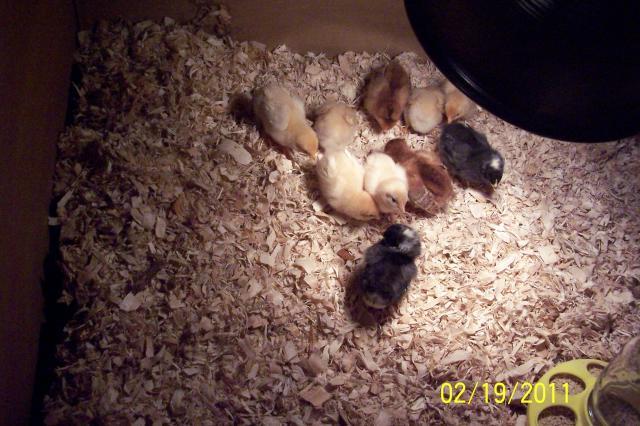
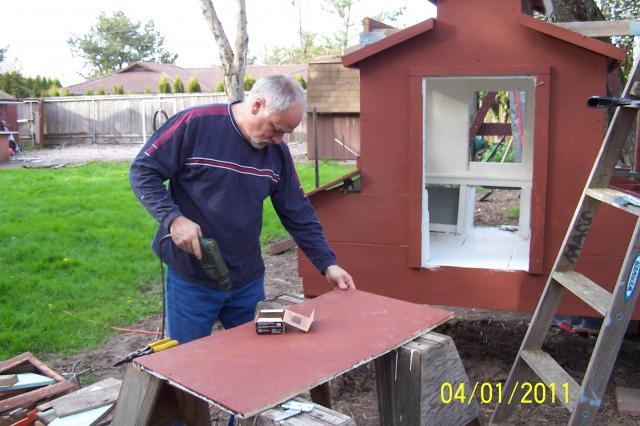
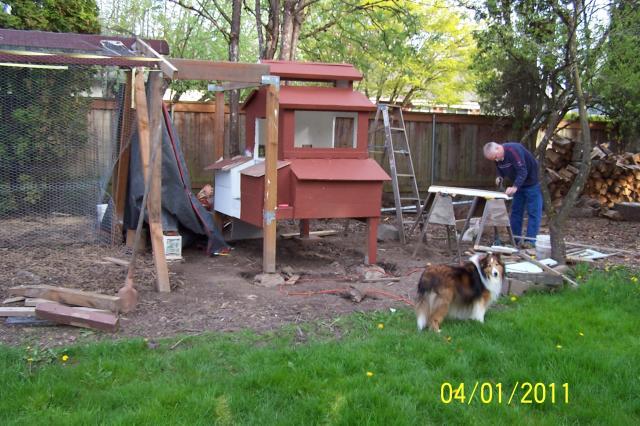
More chicks! We like the big brown eggs our sex links lay...and so do our customer friends.2 Black SL's (Huevos and Foo Young); 4 Gold Sex Links (Muna, Chalah, Eggroll and Frittata) :-D

This year we got our new chicks the "natural way."
Last spring we purchased a Silkie hen at the Canby Chicken Swap. She was a known broody and foster mother. She wanted to brood in November, but I let her sit through without using her so I could know what her behavior was like and at the time had no confidence in winter brooding, having never used a broody. Next, we waited for her to go into a good brood for spring, which occurred late January (her timing not ours). A good friend's daughter had a flock with a rooster, so I rushed out and got some fertile eggs from her. Waiting until night, I swapped out the 2 banty eggs our Silkie was trying to hatch and replaced them with the 5 fertile eggs. She settled in with a glare at me and went into a serious brood.
Candling showed that only 3 would be viable, which indeed hatched on February 8.
Wanting more than 3 chicks, I purchased two, 2 day Wyandotte chicks from a local feed store. Research had told me to wait until night to put them in with the hen to reduce the likelihood she would reject them. However, both died within the next 2 days even though the hen was taking good care of them. After talking with the feed store, we figured out it simply had been too much stress change for the chicks...too many changes in too short a time from hatching to travel from farm to feed store to travel to my home, to being kept in a warm box until night, then trying to adjust to a hen. The feed store willingly replaced the chicks and recommended taking them immediately to the hen.
I did, and the little brood of 5 are happy and healthy with momma hen, who is teaching them how to scratch, how to find food, and keeps them nice and warm in her feathers.
This has been a GREAT project with my hens

At 2 weeks of age. 3 hatchlings and 1 foster chick (silver died due to wandering off into cold).
UPDATE: Unfortunately I could not keep those first fosters alive...they all succumbed to the elements after about 2 weeks of age, and I gave up trying with that hatch. The broody hatched chicks were thriving even in the winter cold, and grew into lovely hens that laid at 14 to 16 weeks of age.
....you can see the rebuilt coop on the right...the second coop on the left (which failed miserably as a brooding coop as the silly broodies wouldn't use it). I keep these as my main coops...each can hold about 8 to 10 for roosting...they free range during the day.The Coops Proper
UPDATE 2015
A lot of brooding has taken place since that first brood in February 2013. My faithful Oma-San (black Silkie) brooded every 3 to 4 months, and I took advantage of that as much as I could. I also used any "volunteer" that would come my way.
It soon became apparent that brooding in the main coop was not going to work well...too many eggs getting stomped on, too many wrong eggs ending up under the broody. Sooo, we built a second coop for the expanding flock...hoping that would be the brooding area. It was still connected to the main coop with run, so it would be ideal? Right? Unfortunately we obviously had forgotten to tell our broody hens as they continued to clog up the main coop. A new plan was needed.
We like to re-use and recycle, so we turned a couple of large, wooden packing crates (the kind companies use to store their product exhibits in) into a rabbit hutch type brooding hutch with its own connected run. This has worked like a charm. I can easily brood 2 hens at a time, (3 in a pinch) and have had as many as 8 to 10 chicks (could do probably 12). The enclosed netted run acts as a grow out pen, and keeps our littlest flock members from becoming hawk dinner as the Cooper's Hawks love to fly by and check out the chicken nuggets. It also allows the main flock to come by and see the new members which eases with flock integration.
Here's photos of my third coop...the designated broody hutch and run:
And some of my projects over the last few years:
Grab bag of eggs that yielded a good broody (seasonal) and a Welsummer (nice dark eggs) and several game mixes
Sadly this winter 2014, I lost my most beloved and faithful broody hen, Oma-San, to one such hawk...I had her free ranging in the yard with the main flock to finish integrating them as her "babies," along with other "babies" the LF hen had long since left on their own but Oma-San was determined should still have a careful motherly eye, were getting too big to be confined in the grow out pen. Of course a hawk picked off the smallest and most valuable member of my flock!
Broken hearted, I began a new search for another seasoned broody by posting an ad on a local Chicken Swap. A kind hearted Silkie owner saw my ad and felt I would be the perfect home for her first Silkie, and beloved broody, who was 4 1/2 years old and being dropped from her breeding program. She gave me what I have dubbed the "Queen Mum." I also had been looking at Cochin bantams as a good brooding possibility, but could only find young pullets. I had arranged to purchase only 1 pullet, after checking with the Silkie breeder that the Queen Mum would be good with Cochin bantams...she would...she had co-brooded with one before. Funny thing happened on the way to the farms...it turned out the Silkie breeder and the bantam Cochin breeder knew each other, and they together determined that the Queen Mum really needed TWO hand maids to wait on her and keep her warm in her new home...I was notified of this fact...and yes, having no control over chicken math especially when being enabled by other chicken lovers, came home with TWO very pretty 4 month old bantam Cochin pullets that were from a very, very broody Buff momma and a very pretty Mille Fleur dad.
My new broodies...I hope to have many stories and pics of their successes shortly...
The Queen Mum (silkie) and her 2 hand maids Rosie and Mimsy (bantam Cochin)
UPDATE March 2015
The Queen Mum supplied me with a lovely brood this February, and I placed 3 Isbar and 2 Isbar/Maran (Olive Egger) eggs with her. She was dutiful and faithful, but for whatever reason we only had 1 OE egg hatch...none of the others developed chicks (all "quitters"). Not wanting just the 1 chick lonely only, I purchased a couple of California Greys to foster with the OE. My white layer is aging, and I like those white eggs next to the dark Marans and greens in the egg box...it really makes the colors "pop."
The Queen Mum and her first brood for me...1 OE...and the 2 Cal Greys with my OE.
What's Next?
My next projects in waiting are Isbars (since I didn't get any this time), probably some more Olive Eggers, some Cream Crested Legbars, some more Welsummers (lost mine this summer), or more BCM's (breeder has a new line with REALLY dark eggs!), and possibly some Croad Langshans...as well as perfecting fostering with feed store chicks to keep half my flock in those super layers of RSL and BSL.
I am hoping to create a really awesome egg basket filled with dark brown, tans, whites, greens, ice blues, and that elusive purple.
Update December 2016: I now have a sweet, pretty Barnevelder rooster with a brooding harem that includes Cream Legbar, Splash Marans, the OE Isbar/Marans, and now several of his lovely daughters. Results to come

My growing egg basket colors

All things bright and beautiful,
All creatures great and small,
All things wise and wonderful,
The Lord God made them all.
All creatures great and small,
All things wise and wonderful,
The Lord God made them all.
